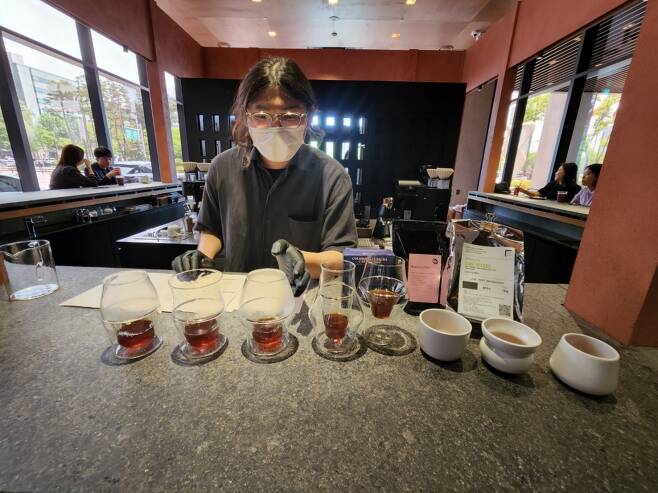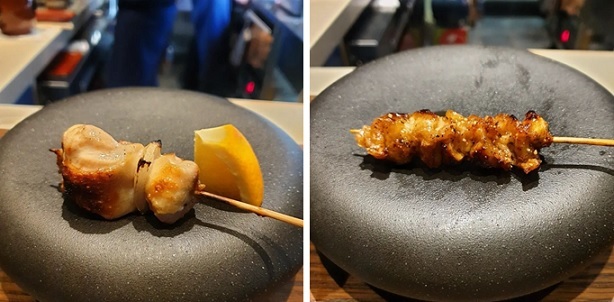[Food] Omakase adds new flavor to Seoul's food scene
이 글자크기로 변경됩니다.
(예시) 가장 빠른 뉴스가 있고 다양한 정보, 쌍방향 소통이 숨쉬는 다음뉴스를 만나보세요. 다음뉴스는 국내외 주요이슈와 실시간 속보, 문화생활 및 다양한 분야의 뉴스를 입체적으로 전달하고 있습니다.
“Omakase” is a traditional Japanese dining style where guests leave their menu choices up to a chef. Literally meaning “I will leave it to you” in Japanese, omakase in Korea usually refers to a high-end dining experience at a Japanese restaurant’s sushi counter. The chef prepares one piece of fish at a time and introduces its name and origin.
Recently, non-sushi items, from tempura, coffee and pork, have also found their way into the local omakase scene.
The following are some restaurants in Seoul offering unique omakase experiences.
One-to-one coffee class
While coffee franchises like Starbucks are a place for daily caffeine intake, omakase coffee bars are for those who would like to delve deeper into the world of coffee.
An omakase session at Conflict Store, a coffee bar located in Sincheon-dong, offers an intimate tasting program curated by experts, with three course tasting menus featuring different brews. The price varies from 40,000 won to 70,000 won ($31-$55), depending on the type of coffee beans.

At the beginning of each course, a barista offers a cup of ground coffee beans so that guests can enjoy various coffee aromas: sweet, fruity, floral and smoky.
While pouring hot water on the beans to brew coffee, the barista explains the beans’ characteristics, including their taste and origin.
A pot of fresh coffee is then served in two or three cups that are different in shape and size.
“The scent of brewed coffee lingers longer if it’s poured in a glass cup with a small opening. During our tasting sessions, customers can better appreciate the taste and scent of coffee with baristas’ step-by-step guide,” explained Lee Jae-dong, a Conflict Store employee.
Similar to a Japanese sushi bar, the coffee shop has a L-shaped ceramic counter surrounding the coffee brewing station and the checkout counter so that customers can watch baristas roast beans and brew coffee.
Conflict Store Jamsil
●209 Jamsil-ro, Songpa-gu, Seoul (02) 424-5115
●Open daily from 8 a.m. to 10 p.m.
●Coffee omakase costs 40,000 won to 70,000 won

Crispy pleasure
Tempura, a typical Japanese food consisting of seafood, meat and vegetables that have been battered and deep-fried, is a popular side dish for sushi among Koreans.
Recently, the crispy garnish has been served as an entree at many Japanese restaurants here as “tempura-specialized omakase.”
A 12-piece tempura omakase offered at Japanese dining bar “Kushiage Jin” in Cheongdam-dong comes with various tempura offerings, including shrimp, oyster, abalone and Korea beef.
At a bar table, patrons can observe the traditional art of tempura making as chefs explain each course meal in detail, while showing fresh ingredients before deep frying.
“The ingredients of our chef-curated tasting menu varies depending on the season. We offer in-between side dishes like Japanese spinach salad or spicy udon in each piece-by-piece multi course meal to prevent the food from feeling too greasy to diners,” according to Shin Ji-myung, who works at Kushiage Jin.
A variety of Japanese dipping sauces are paired with each piece of tempura, including sesame, soy, ponzu and teriyaki, to enrich the flavor of fried dish, Shin added.
Kushiage Jin
●52 Seolleung-ro 148-gil, Gangnam-gu, Seoul 0507-1318-1957
●Open daily from 4 p.m. to 9 p.m., closed on Sundays
●Tempura omakase costs 120,000 won

Taste different chicken cuts
The piece-by-piece course meal of “yakitori,” a Japanese dish of grilled chicken skewers, has captivated the taste buds of chicken lovers in Korea, who invented “chimaek,” (fried chicken paired with beer).
At the yakitori omakase bar “Kushiho,” located in Bangbae-dong, chefs cook chicken skewers over a narrow charcoal grill in front of a bar table on which plates of the juicy meat pieces are served one after another.
Its dinner course presents six types of yakitori made from different parts of the chicken such as the breasts, thighs, skin, liver and other innards.
Seasoned with different flavors, including soy and spicy sauce, the grilled chicken skewers are perfect to have with beer.

“Each plate of yakitori has a unique taste and texture. It’s fun to compare flavors. Also, I like that a yakitori omakase isn’t a heavy meal as the chicken skewers are bite-sized,” said Jeong, a 32-year-old office worker in Seoul.
Meanwhile, various side dishes, including three pieces of sashimi, croquettes and boiled fish, add variety to a course meal.
Kushiho
●93 Donggwang-ro, Seocho-gu, Seoul 010-5445-4383
●Open daily from 11 a.m. to 4 p.m., closed on Mondays
●Yakitori omakase costs 35,000 won to 100,000 won

Feast of grilled pork dishes
Samgyeopsal-gui, grilled Korean pork belly meat, is one of the most popular ways of eating pork in Korea. One can easily find smoke-filled Korean restaurants on streets of Seoul, where people grill sliced pork belly on a table grill pan.
But some foodies seeking to taste different cuts of pork besides samgyeopsal are turning their eyes to restaurants offering pork omakase.

Chefs at “Don Tamguso,” in Magok-dong present a 10-course experience which features pork belly, pork tenderloin, pork ribs, pork neck, pork chops and pork skirt that are either grilled or boiled.
Every dish is served with different Korean garnishes, including kimchi and roasted garlic which match well with the grilled or boiled pork bites. Some grilled meat is marinated with doenjang, or Korean fermented soybean paste.
The last menu of the dining course is a pot of bubbling hot doenjang jjigae, Koreans’ favorite hearty comfort food.
“We offer various Korean garnishes and seasonings to bring out the meat flavors more. Foreign patrons can get a glimpse of Korean traditional food by trying out various types of Korean-style grilled pork,” said Kim Hyung-seok, who launched the pork omakase restaurant last month.
Don Tamguso
●11 Magokjungang 6-ro, Gangseo-gu, Seoul 0507-1311-6837
●Open daily from 11:30 a.m. to 10 p.m.
●Grilled pork omakase costs 26,000 won to 48,000 won

Explore fresh pasta
Omakase-style dining has even extended to Italian cuisine.
The pasta omakase at Cement Hannam, a small Italian restaurant in Hannam-dong, consists of four different kinds of fresh pasta made with both Korean and Western ingredients, including green onion, seaweed, truffles and Italy’s traditional Bolognese meat sauce.
A small plate of beef tartare, pulled pork tacos and fruity gelato are served as in-between side dishes.

Before the course meal starts, chefs show different pasta doughs to guests sitting on a bar table and give background information such as how to make each dough, their texture and how Italians cook them.
“I love the soft and chewy texture of handmade pasta. Through omakase dining, I could not only enjoy various tastes of exotic dishes, but also learn about exotic recipes and ingredients,” said Cho Soo-hyun, a 27-year-old office worker living in Yongsan-gu.
Cement Hannam
●48 Hakdong-no 77-gil, Yongsan-gu, Seoul (02) 749-7272
●Open daily from 5 p.m. to 11 p.m.
●Fresh pasta omakase costs 85,000 won
By Choi Jae-hee (cjh@heraldcorp.com)
By Choi Jae-hee(cjh@heraldcorp.com)
Copyright © 코리아헤럴드. 무단전재 및 재배포 금지.